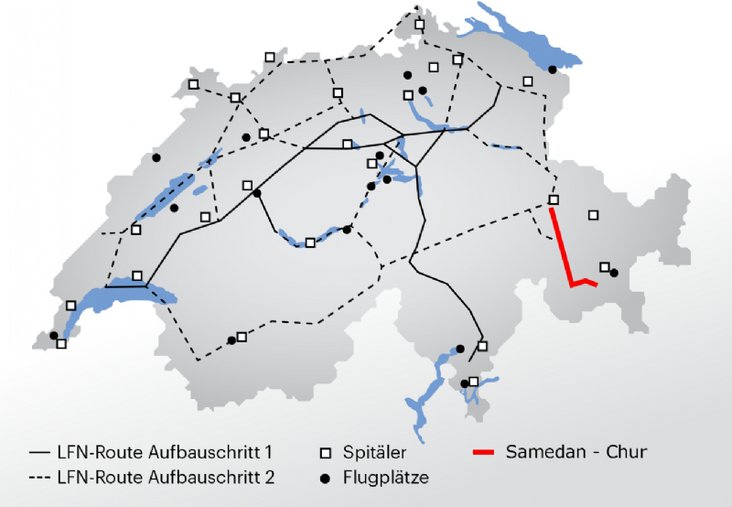Before the new instrument flight route can be approved by the Federal Office of Civil Aviation (FOCA), it first needs to be extensively tested. To this end, from 20 to 24 July a Rega AgustaWestland Da Vinci helicopter will fly between 30 and 40 times from Samedan to Chur. The route leads over the topographically challenging terrain of Engadin Airport (the highest airport in Europe), over the Julier Pass, via Savognin through the Surses valley, on to Thusis, and finally to Graubünden Cantonal Hospital in Chur. On board the helicopter are various measurement devices that will record the exact position data throughout the flight. This makes it possible to check whether the route can be flown according to instrument flight rules (IFR) with the necessary precision.
Network of instrument flight routes for helicopters
Every year, bad weather currently prevents around 600 people in Switzerland from receiving emergency assistance from the air. Rega wants to change this situation and in future help even more people in distress. It has therefore launched a series of measures that will enable its helicopters to also be able to fly when visibility is poor (see www.ifr.rega.ch). Rega is, among other things, working closely with the Swiss Air Force and Skyguide air navigation service to establish a network of instrument flight routes. This so-called Low Flight Network (LFN) is based on satellite navigation and will link airfields with permanent IFR infrastructures, as well as hospitals and smaller airfields with specially designed approaches, with each other. In collaboration with the European project group, PROuD (PBN Rotorcraft Operations under Demonstration), the precision of this technology will be examined in the course of the test flights from Samedan to Chur. PROuD promotes the introduction of satellite-based helicopter flight procedures and is funded by the European Union, the aviation industry and the European air traffic control authority.
Improved provision of emergency medical care from the air
Among those who will profit from instrument flight routes are people living in the peripheral regions, who in a medical emergency can be flown to a central hospital no matter what the weather. For example, even despite low cloud cover, Rega will be able to fly premature babies from Samedan via the instrument flight route over the Julier Pass to Chur or Zurich. Babies that are born in the Engadin before the 34th week of pregnancy need to be transferred to a central hospital. In such cases, it is vital that the patient spends a minimum amount of time away from the hospital, so the fastest transport possible is of key importance. Until now, the only possibility has been a lengthy journey by road. Other intensive care patients will also benefit from this new flight procedure.
Rega Media Service
Adrian Schindler
Instrument flights for helicoptersFor commercial aircraft, flying according to instrument flight rules (IFR), whereby pilots rely on the instruments in the cockpit and the information provided by air traffic control, is standard procedure. Now Rega wants to use IFR for its rescue helicopters - but the challenges are manifold. For one thing, during rescue missions Rega helicopters fly lower than commercial aircraft and outside defined air corridors. Furthermore, flying in adverse weather conditions poses particular demands on crew training and the technology of the helicopter. For this reason, Rega is currently looking at purchasing helicopters with a de-icing system. The Rega video, "Rescuing people anywhere and in all weathers", looks at Rega's vision for the future. |

